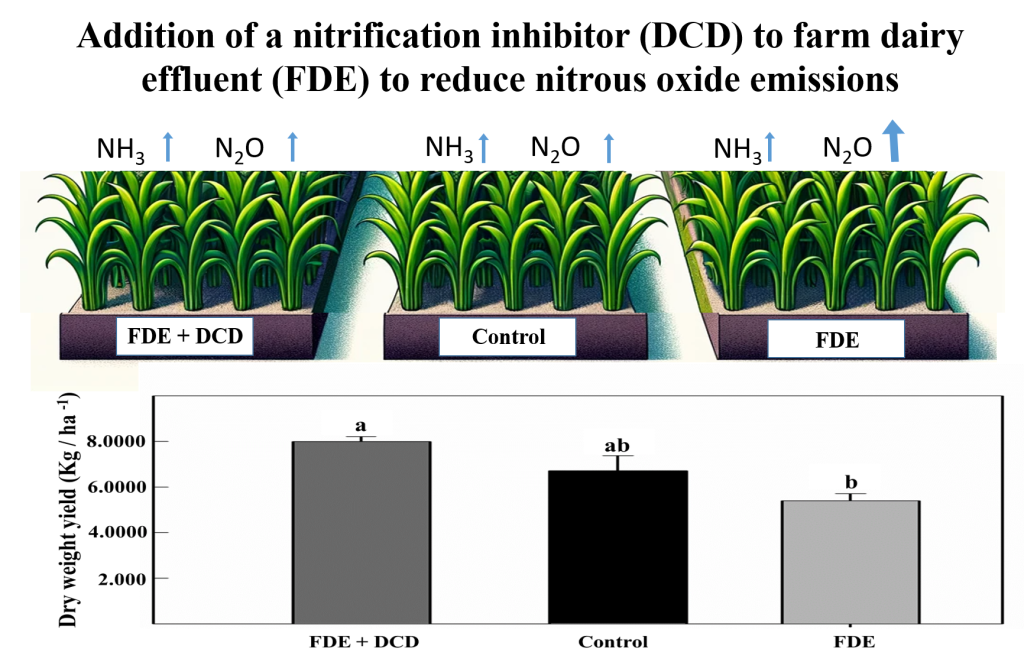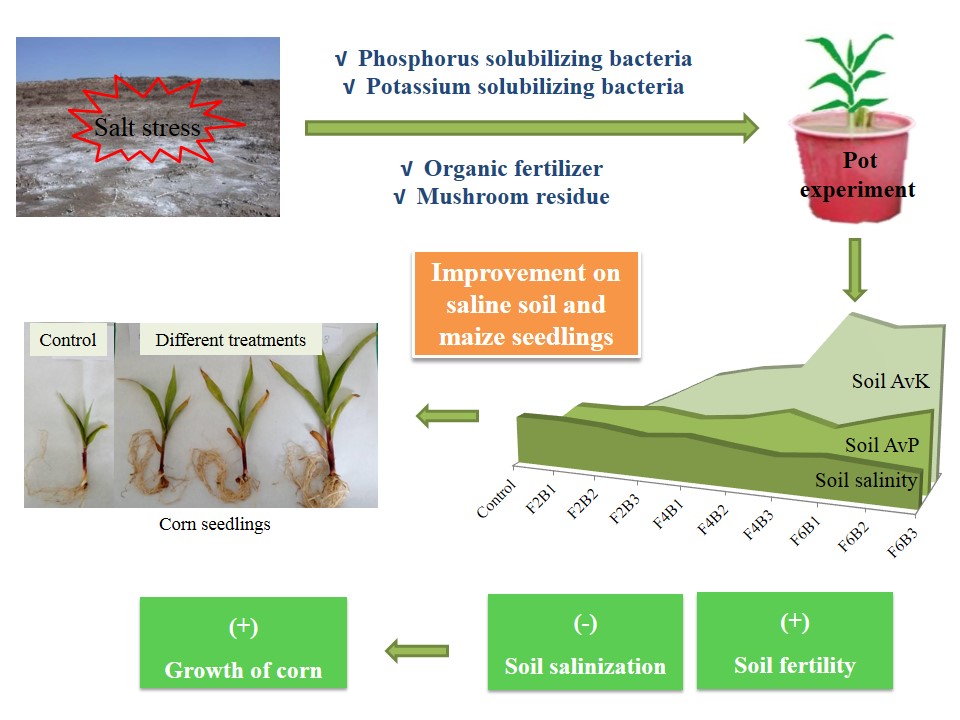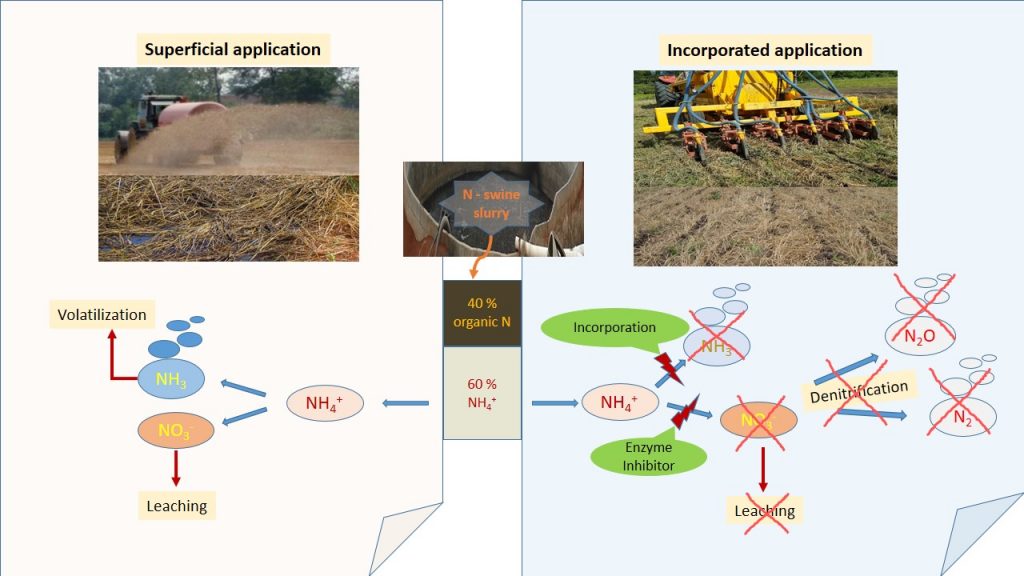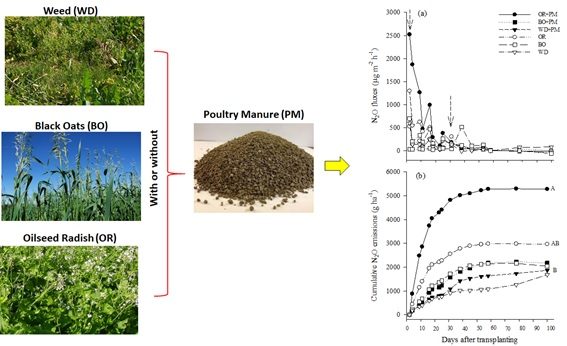Nitrification inhibitor addition to farm dairy effluent to reduce nitrous oxide emissions
11/Mar/2024
ABSTRACT Increasing the use of nitrogen (N) fertilizers will be necessary to enhance grain and pasture yields to satisfy the growing world demand for food. Organic amendments, such as farm dairy effluents (FDE), are an alternative to traditional synthetic fertilizers. However, part of the applied N could be lost as ammonia (NH3) volatilization or nitrous oxide (N2O) emission, decreasing N availability to plants. Nitrification inhibitors, such as dicyandiamide (DCD), suppress the microbial process of nitrification, decreasing soil nitrate concentration and, […]
Organic material combined with beneficial bacteria improves soil fertility and corn seedling growth in coastal saline soils
18/Aug/2020
ABSTRACT Soil salinity is a major abiotic stress on plant growth in coastal saline soil. The objective of this study was to screen the optimal combination of organic materials with beneficial bacteria for application under real field conditions to improve coastal saline soil. A two-factor pot experiment was carried out with corn in coastal saline soil for 26 days. In the naturally aerobic environment, a split-plot experiment was conducted with different rates of organic materials (organic fertilizer and mushroom residue) […]
Incorporation in soil and addition of enzyme inhibitor as a way to increase the efficiency of pig slurry and mineral fertilizer
07/Jan/2020
ABSTRACT The incorporation of nitrogen (N) fertilizers in the soil and the use of enzyme inhibitors (EI) can improve the efficiency of N fertilization by reducing losses by ammonia volatilization and nitrate leaching. This study aimed to evaluate the efficiency of EI addition and fertilizer incorporation on both grain and dry mass yields of corn as well as on some soil chemical properties, with focus on N availability. A field experiment was carried out for three years in randomized blocks […]
Nitrous Oxide Emissions in No-Tillage Onion ( Allium cepa L.) Crops Are Increased by Oilseed Radish Cover Crop and Poultry Manure Application
10/Apr/2019
ABSTRATO O uso de plantas de cobertura e de esterco de galinha (PM) é uma alternativa para reduzir o uso de insumos sintéticos e pode contribuir para o ciclo de nutrientes em cebolas ( Allium cepa L.) cultivadas em sistema plantio direto. No entanto, esta prática de gestão pode contribuir para um aumento das emissões de N 2 O para a atmosfera. Os objetivos deste estudo foram avaliar o efeito imediato sobre as emissões de N 2 O da adição […]
Use of Organic Compost Containing Waste from Small Ruminants in Corn Production
05/Oct/2016
ABSTRACT Composting is a useful way of transforming livestock waste into organic fertilizer, which is proven to increase soil nutrient levels, and thus crop yield. Remains from production and slaughter of small ruminants can become a source of important elements for plant growth, such as N, after microorganism-driven decomposition.The aim of this investigation was to evaluate the effects of this compost on soil fertility and on the nutritional status and yield of the corn crop. The experiment was conducted in […]
Soil Solution Nutrient Availability, Nutritional Status and Yield of Corn Grown in a Typic Hapludox under Twelve Years of Pig Slurry Fertilizations
22/Jul/2016
ABSTRACT Nutrient content in soil solution may vary in response to the applied amount of pig slurry (PS). Thus, the aim of this research was to evaluate the nutrient content in soil solution and its relationship to nutritional status and yield of corn under 12 years of annual fertilization with increasing doses of PS, soluble mineral fertilizer (MF) and PS combined with MF. The experiment was conducted under field conditions in a Latossolo Vermelho Distroférrico (Typic Hapludox). The treatments consisted […]
Carbon and nitrogen losses with liquid catlle manure from a clayey oxissol under no-till and natural rainfall
01/Dec/2012
The transport of pollutants via runoff in agricultural areas, mainly in soluble forms, is an environmental problem, even in conservation tillage systems. The objective of this study was to evaluate losses of nitrogen and organic carbon in runoff, after applications of 0, 60, 120, and 180 m3 ha-1 yr-1 of cattle slurry to a clayey Oxisol, with 10 % slope under no-tillage and natural rainfall, in the region of Castro – PR. The application of cattle slurry did not affect […]
Macronutrient availability and maize yield after swine slurry applications to an oxisol
01/Dec/2012
Swine manure (SM) applications to maize under no-tillage were tested in a 10-year field experiment to define the appropriate rates. The responses in yield and soil property to the treatments were evaluated: SM at rates of 0, 25, 50, 100 and 200 m3 ha-1; soluble fertilizer (SF); and SM plus soluble fertilizer (SM + SF), all annually spread on the soil surface. The soil pH was not affected by SM, but at rates > 100 m3 ha-1, the exchangeable Ca […]
Year-round poultry litter decomposition and N, P, K and Ca release
01/Jun/2012
Poultry litter is an important nutrient source in agriculture, although little information is available regarding its decomposition rate and nutrient release. To evaluate these processes, poultry litter (PL) was applied to the soil to supply 100, 200 and 300 kg ha-1 N contained in 4,953, 9,907 and 14,860 kg ha-1 PL, respectively. The litter bag technique was used to monitor the process of decomposition and nutrient release from the litter. These bags were left on the soil surface and collected periodically (after 15, 30, 60, […]
Transformation of organic matter and nitrogen during composting of the solid fraction of cattle slurry
01/Oct/2008
Cattle slurry solid fraction (FSC1 and FSC2, collected from open and closed sinkholes, respectively) was collected from two dairy farms and composted with and without straw, in static and in turned piles. Thermophilic temperatures were attained soon after separation of FSC1, which was collected at lower rate, and increased to a daily maximum temperature of 68 °C in the static pile with straw. However, the temperature in the FSC2 piles did not reach temperatures above 51 °C. Straw addition to slurry solid […]




